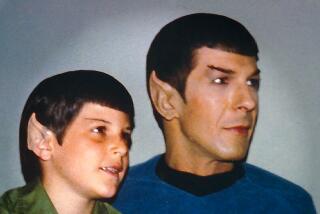Spock’s Futuristic Gesture Grew From Ancient Roots
- Share via
Actor Leonard Nimoy of “Star Trek” fame remembers well that mysterious moment on a long-ago Shabbat.
Seated in an Orthodox synagogue in Boston with his brother, father and grandfather, Nimoy, then 8, had dutifully done as his father had asked. During a climactic moment in the service, he was told not to look.
He covered his eyes with his hands. From the direction of the ark he could hear Hebrew words surge over the congregation’s bowed heads -- words infused with a passion so palpable that the boy did what any 8-year-old would do. He peeked.
“I was awestruck,” Nimoy, 73, recalled in a recent interview. “I had no idea what was going on. And my father was saying, ‘Don’t look!’ And the whole congregation have their eyes covered with their hands and their heads covered with their prayer shawls.”
To this day, he said, he has never forgotten what he saw. Facing the congregation were five or six men, their heads covered by talitot, or prayer shawls, their arms uplifted.
“The Lord bless you and keep you,” they chanted in Hebrew, pronouncing the priestly blessing, the Birkat HaKohanim. But the boy wondered: What did the sign mean that they made with their fingers and thumbs? Their chanting continued without offering a clue. “The Lord make his face to shine upon you, and be gracious to you; the Lord lift up his countenance upon you, and give you peace.”
“I had no idea what it meant,” Nimoy said of the gesture. “But I was affected by it.”
Years later, the sign became known to millions around the world as the salute in the “Star Trek” television and motion picture series in which Nimoy starred as Spock, the ultra-rational Vulcan who served as science officer on the Starship Enterprise.
During development of the series, Nimoy said, the writers were looking for something that would be distinctive about the Vulcan culture. “Why not do this,” he said, imitating the priestly hand sign in which the thumb is held separate and the other fingers are split in groups of two. “So I introduced that gesture,” he smiled, agreeing that in retrospect it could be seen as subversive.
The three-pointed hand sign forms the Hebrew letter shin, the first letter in Shaddai, one of the mystical Hebrew names for the Almighty.
Rabbi Yitzchok Adlerstein, who is Orthodox and head of Jewish Law and Ethics at Loyola Law School in Los Angeles, explained that in Cabalistic or Jewish mystical thinking, bringing the two hands together with the thumbs touching creates a space or window through which the divine presence comes down upon the outstretched hands and then flows to the congregation.
“Out of respect for the notion that the divine presence is there, people a long time ago had this custom of not looking,” Adlerstein said.
Since Nimoy popularized the hand sign as a Vulcan salute and went on to help write the story for “Star Trek IV: The Voyage Home” in 1986 and produced “Star Trek VI: The Undiscovered Country” in 1990, he has continued on a spiritual trek of his own. This Sunday at 3 p.m., for example, he will be the storyteller at Temple Israel of Hollywood for the West Coast premiere of Cantor Charles Osborn’s oratorio “Souls on Fire,” which tells the stories of six charismatic leaders of the Hasidic movement. Based on a book of the same name written by Elie Wiesel, the oratorio features the Los Angeles Jewish Symphony. Nimoy previously served as the storyteller for “Souls on Fire” in Philadelphia, Boston and Lincoln Center in New York, and recorded a compact disc.
He and his wife, Susan, decided to launch the Nimoy Concert Series, now in its third year, after attending a performance by pianist Emanuel Ax at the synagogue several years ago.
For Nimoy there is a sense of fascination and alienation when he speaks of Hasidic Judaism -- and echoes of his boyhood. “There was something magical about them that inspired a passion,” he said of the six leaders portrayed in “Souls on Fire.”
Yet, today, he said, he could not agree with much of the social and political stands of Hasidic Judaism. Temple Israel of Hollywood, which he and his wife attend, is in the Reform movement, one of the two major liberal streams of Judaism in the United States. “I’m much more secular than religious, I would say.”
“It bothers me in a certain kind of way there are these conflicts,” he said. “But beyond that, I think they’re sincere in their great passion, and in a way I feel that they help us ground ourselves in the history. To me, it’s the historical aspect,” he said. All Jewish denominations, he said, “carry something of a flame of what the history is all about, what the culture is all about.”
More to Read
The complete guide to home viewing
Get Screen Gab for everything about the TV shows and streaming movies everyone’s talking about.
You may occasionally receive promotional content from the Los Angeles Times.






